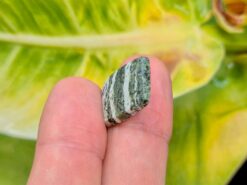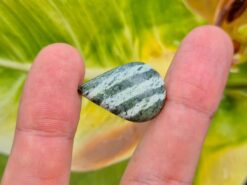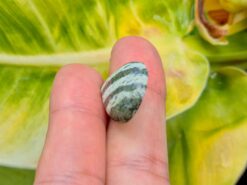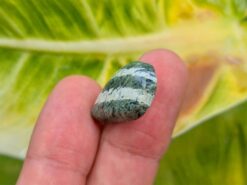Chrysotile

Chrysotile or amosite asbestos is one of the 3 types of asbestos.
Buy natural chrysotile in our shop
Chrysotile asbestos
The stone is one of the 3 types of asbestos with actinolite and tremolite. Incorrectly named Swiss opal, zebra jasper, lizard skin jasper, dragons scale stone, or green roes opal is the most commonly encountered form of asbestos, accounting for approximately 95% of the asbestos.
It is a soft, fibrous silicate mineral in the serpentine subgroup of phyllosilicates, as such, it is distinct from other asbestiform minerals in the amphibole group. Its idealized chemical formula is Mg3(Si2O5)(OH)4.
Properties
Wrongly named opal or jasper because most of the gem traders are not gemologists and name the stones based on their appearance. Most opaque stones are called jasper, and the name opal is probably due to the low density, which is close to opal density.
To identify the stone, there is a very simple test method, just put it in the water for a minute. The fibrous and dry structure of the stone will allow it to absorb water. The stone will therefore be heavier afterwards while neither opal nor jasper will be heavier after being submerged for one minute in water.
Polytypes
Three polytypes are known. These are very difficult to distinguish in hand specimens, and polarized light microscopy must normally be used. Some older publications refer to this stone as a group of minerals, the three polytypes listed below, and sometimes pecoraite as well, but the 2006 recommendations of the International Mineralogical Association prefer to treat it as a single mineral with a certain variation in its naturally occurring forms.
Clino is the most common of the three forms, found notably at Asbestos, Quebec, Canada. Its two measurable refractive indices tend to be lower than those of the other two forms.
The orthorhombic paratypes may be distinguished by the fact that, for orthochrysotile, the higher of the two observable refractive indices is measured parallel to the long axis of the fibres (as for clinochrysotile), whereas for parachrysotile the higher refractive index is measured perpendicular to the long axis of the fibres.
Physical properties
The stone has a hardness similar to a human fingernail and is easily crumbled to fibrous strands composed of smaller bundles of fibrils. Naturally occurring fibre bundles range in length from several millimetres to more than ten centimetres, although industrially processed stone usually has shorter fiber bundles.
The diameter of the fibre bundles is 0.1–1 µm, and the individual fibrils are even finer, 0.02–0.03 µm, each fibre bundle containing tens or hundreds of fibrils.
The stone fibers have considerable tensile strength, and may be spun into thread and woven into cloth. They are also resistant to heat and are excellent thermal, electrical and acoustic insulators.
Chrysotile under microscope
Safety concerns
There is no danger in handling polished gemstones than contain one of the 3 types of asbestos minerals. Pietersite, serpentine or nephrite. All are used in jewelry. The danger is in breathing the powdered mineral. Most lapidary work is done with water. You should never cut or polish these minerals dry, so you could have a warning on your gemstone listings to let people know not to grind it up and inhale it.
FAQ
What is chrysotile made from?
Asbestos is the only known type of asbestos that belongs to the serpentine family. Also known as white asbestos, this variety is made up of curly fibers and has a layered structure.
How is chrysotile formed?
The stone formation arises through serpentinization of ultramafics and silicified dolomitic limestones. Rock types tend to control the trace metal content and both the nature and amounts of admixed minerals in the ore, such as fibrous brucite (nemalite) and tremolite.
Does chrysotile cause mesothelioma?
Two cases of malignant mesothelioma, one pleural and the other peritoneal, were found in the asbestos cohort. These results suggest that heavy exposure to pure asbestos alone, with negligible amphibole contamination, can cause lung cancer and malignant mesothelioma in exposed workers.
Does chrysotile dissolve in lungs?
Serpentine fibers are seen in autopsies, but their numbers do not correlate with pleural plaques, and a recent publication suggests that they are dissolved in lung tissue macrophages in 3–6 months, rather than 50 + years for amphibole fibers.
Where is chrysotile mined?
The major producing countries of asbestos are Russia (39%), Canada (18%), China (14%), Brazil (9%), Kazakhstan (7%), and Zimbabwe (6%). In 2000, active mining operations of amosite asbestos fibers are found in 21 countries.
Is it a mineral?
The stone also known as white asbestos, is the most exploited asbestos mineral and is the only regulated serpentine mineral. Other serpentine minerals that can occur in a fibrous habit are lizardite and antigorite.
Natural chrysotile for sale in our shop
We make custom made chrysotile as engagement rings, necklaces, stud earrings, bracelets, pendants… Please contact us for a quote.
















